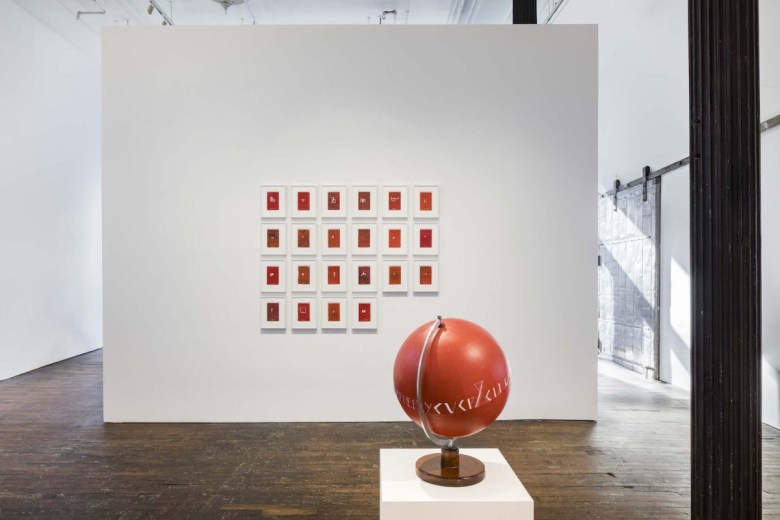From Scratch at Peter Freeman Inc., which features five Eastern European artists, highlights a common desire among the artists that “art should proceed from the basic, elemental, and essential,” as the press release states, while still reflecting on the aesthetic and sociopolitical issues of their geographical and historical contexts. Organized by Croatian art critic and curator Branka Stipančić, the exhibition showcases conceptual artworks produced between 1949 and 2020 by Mangelos, Mladen Stilinović, Julije Knifer, and Goran Trbuljak, all from Zagreb, Croatia (formerly Yugoslavia); and Július Koller, from Bratislava, Slovakia (formerly Czechoslovakia). For these artists, starting from the elemental meant raising existential questions on the use of language and humor or irony in art. The works refer to or draw on alphabets, dictionaries, notebooks, book covers, and word games — From Scratch takes the viewer back to early classroom learning.
Mangelos’s Tabula Rasa series (1951–56), which consists of 10 tempera drawings of black rectangles, sets up the main theme of the exhibition: how each of the artists conceived art as a communication tool that needed to be set free from the past in order to move forward. The artist’s (1921–1987) work examines how to spell, write, and form words, and his other pieces in the show include alphabets, a globe, and the handwritten name “Pythagoras.” The rectangles carry multiple meanings that situate the work in a historical context, and can both counter and underscore the idea of a “tabula rasa” — in his notebook he used them to depict black graves to acknowledge the absence of friends and relatives killed in World War II.

Artist Mladen Stilinović (1947–2016) brings in audience participation. Visitors are invited to play his dice game “Pain Game” (Igra–Bol; 1977) at the front desk for seven minutes. However you roll the dice, the result is always the same: the surface always reads “pain.” In “Dictionary – Pain Letter A” (2011), the artist substituted the definitions of all the words beginning with the letter “a” with the word “pain.” A statement on his website reads: “When I say pain, questions are immediately raised: what pain, whose pain, wherefrom the pain, as if pain had to be explained, analyzed. There’s nothing to be explained…. the pain is there.”
Both Julije Knifer (1924–2004) and Goran Trbuljak (b. 1948) used basic forms to assert a critical relation to painting and drawing. Knifer — who, like Mangelos, was a member of the neo-avant-garde Gorgona group — reduces the visual to its basic elements. His canvases on display repeat the same black and white vertical and horizontal lines. Trbuljak, the only living artist in the show, captures the concept of artist’s preparation in an absurd limbo. In 1974 he began the preparatory drawings “Exercise of an Artist,” in which he exercises his eyes and hands by writing dots in square notebooks, without ever moving past the “exercise.”
Július Koller (1939–2007) transformed and questioned language by painting question marks on everyday objects, sometimes as a performance (documented here through photographs). Unlike Yugoslavia, which had moderate communist policies, Czechoslovakia had a stricter approach to artistic and personal freedoms. For the artist, a simple question mark was a universal sign of doubt and uncertainty across humankind that resonated with his country’s sociopolitical instability.
The aspiration of the Yugoslavian state for the modernization of the country was to support artists and the neo-avant-garde. Artists were encouraged to explore a new language, questioning traditional conceptions of the art object. Teaching something new was aligned with the utopian socialist idea of the new man — the ideal citizen and human of the future.
From Scratch: Mangelos, Julije Knifer, Július Koller, Mladen Stilinović & Goran Trbuljak continues at Peter Freeman, Inc. (140 Grand Street, Soho, Manhattan) through April 16. The exhibition was curated by Branka Stipančić.